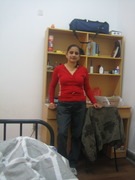I just came back from India due to complications with my heart. While I was in India I started having chest pains and discomfort and took myself to the nearby hospital. The cardiologist who examined me decided that he was going to do an angiogram to determine if the pain is due to my heart condition. I wanted to get a second opinion and was told by the second cardiologist that I did need an angiogram because of my previous history. I was scheduled for an angiogram the next day.
I dreaded the angiogram and remembered the last time I went through angioplasty and stent placement while I was in United States. I was under the impression that the procedure is done through my femoral artery as I did before which left a bitter memory in my mind. I remembered the painful experience and it sent chills through my spine. To my utter surprise the cardiologist used my radial artery that took less than couple of hours for the whole procedure from preparation to recovery. The actual procedure took less than twenty minutes. Cardiac catheterization is done by inserting a catheter into the artery and passing it through the coronary arteries. A contrast medium is then injected through the vessels in order to visualize them and determine the blockage in the arteries. Depending on the extent of the blockage, decision and implementation of angioplasty and stent placement is taken at the time. Angiography through the groin area is very painful for the patient to go through and usually takes five to six hours for the whole procedure. Because of the depth of the femoral artery it is difficult to locate the vessel. During and after the procedure patient has to lie down on their back which causes them to end up with back pain. With radial artery approach patient does not need to be stationary and can move with in an hour. After the procedure a bandage is placed on the incision site and the arm has to be held upward for several hours to twenty four hours. The femoral artery approach patient has to be taking rest for at least a week and cannot move the leg for the duration. Pre-medications are injected through the radial artery for keeping the vessel open during the procedure. Lidocaine is injected at the puncture site to numb the area as opposed to the slight sedation that was given to me when I had the femoral angiogram. Bleeding complications are less with radial artery approach. The patient can move freely and usually can go back to the regular routine after a day of rest.
I was taken into the cath lab at 12:30 p.m. for preparation and was brought out at 2. I was kept under observation for an hour and sent home. I carried on a conversation with the cardiologist while I went through the procedure and watched my heart being worked on. He explained the details of my heart while he performed the test and was done before I realized it. It took less than twenty minutes for my exam to be complete. I could move my arm freely and healed within two days after the procedure. The bruise and swelling stayed on for a week after that. But it subsided eventually. Sure enough I was diagnosed with another blocked artery this time and was told to go through the angioplasty and stent once I returned to United States. I know this time it would not be as simple and smooth as the angiography through my radial artery. I was glad to get off so easy this time.
Radial angiography is the procedure that not only assures more patient comfort and less recovery time but also reduces time of hospital stay and in turn exam costs for patients considerably. I am sure patients like me who go through difficult times with these kinds of procedures will appreciate relatively easy procedures like this one tremendously because, OUR LIFE MATTERS.





Add a CommentComments
There are no comments yet. Be the first one and get the conversation started!